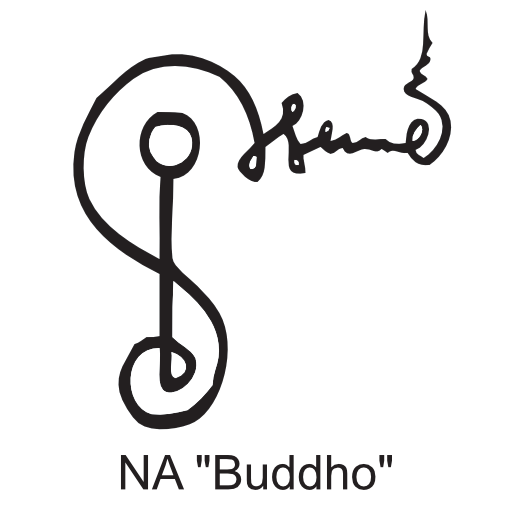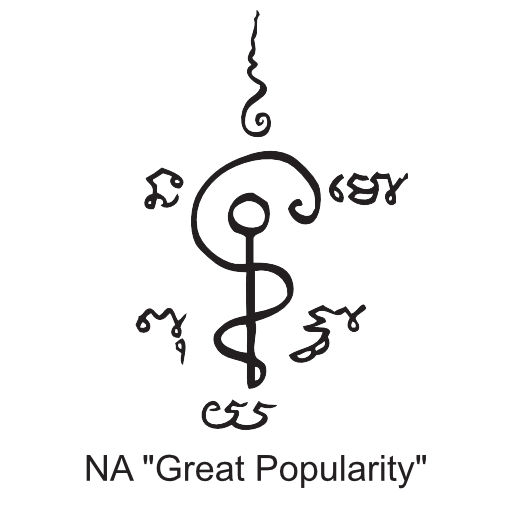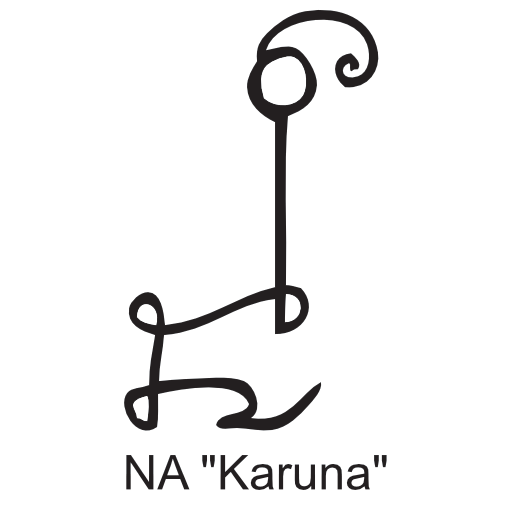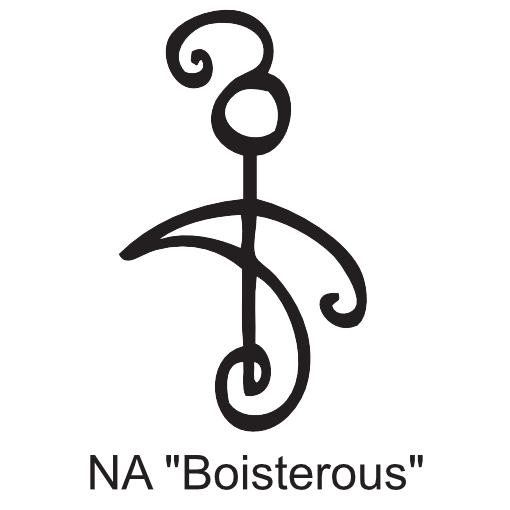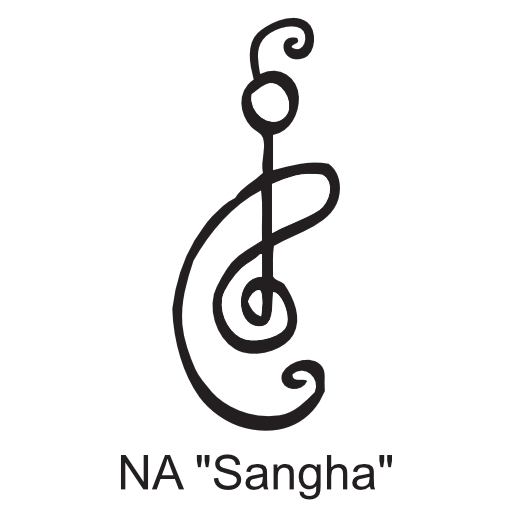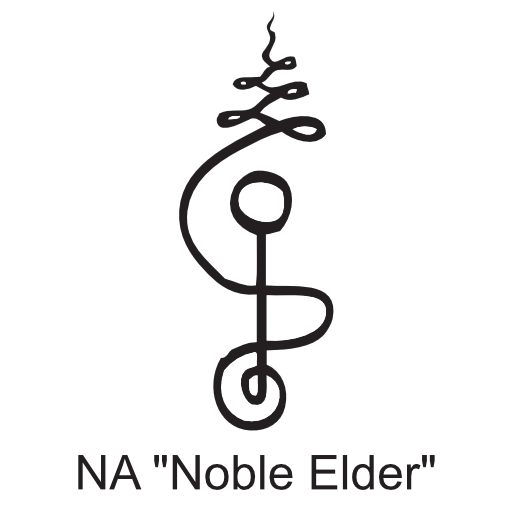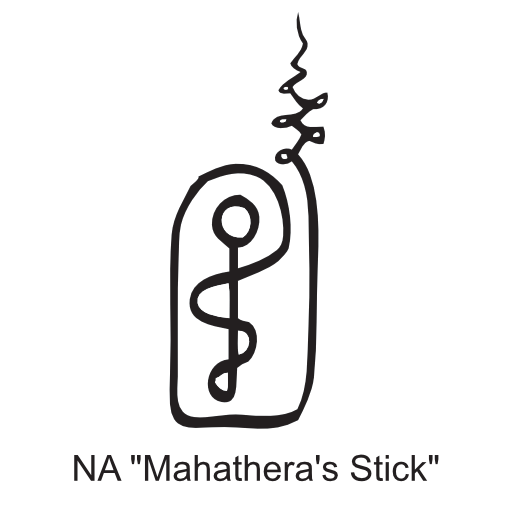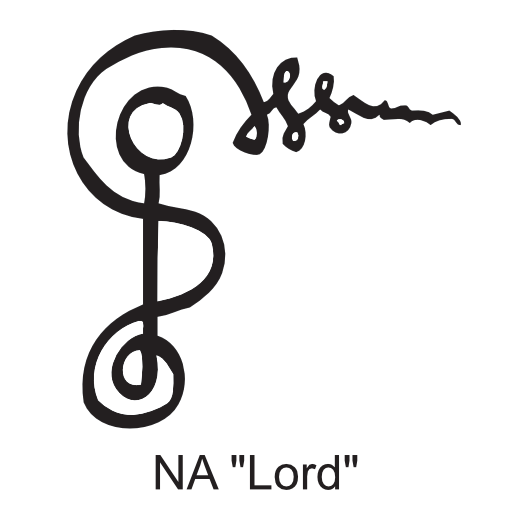
Okāsa
namo tassa Bhagavato arahato sammā-sambuddhassa
namo tassa Bhagavato arahato sammā-sambuddhassa
namo tassa Bhagavato arahato sammā-sambuddhassa
Tantra, mantra and yantra (Pāli yanta, Thai yan) are words with an evocative edge. They immediately arouse interest, and they are also inextricably interlinked. Tantra, from the root tan to extend, means an elaboration, for example a text dealing with a samatha technique; and mantra, from the root man mind, has the sense of guiding or binding the mind. A yantra, the lesser-known term, from the root yam to support, is a supporting device or technique, with a quality of precision.
Yantras are particularly relevant to the samatha meditator since they deal with subtle form, the creative realm responsible for "that which, previously unknown, comes to be known", some would say also for genius and magic.
Yantra of Southeast Asia are generally much simpler than northern-Buddhist mandalas; they have a linear form and usually include syllables as part of the yan. Lines are drawn in a single fluid stroke and the characters “placed” with intention and awareness - both a physical and mental act. They may be drawn on paper, cloth (usually robe cloth), silver, copper or gold foil, or as tattoos.
Sacred Syllables
Buddhism was originally an oral tradition, and when characters came to be used to write down teachings they themselves became objects or forms containing something of the essence or meaning of that which was previously transmiitted orally. Texts were written with reverence on palm leaves, and became a treasure of a temple. Many of the palm-leaf manuscripts discovered in Thailand and Cambodia use the old Cambodian khom script with an interspersing of Pāli characters, and the gift of a sutta written on palm leaves was accorded the highest respect as an act of merit.
The syllables used in yantra are mostly written in the khom script, and the characters themselves are regarded as empowered objects, not unrelated to a meditator’s experience of the subtle body. Some of the most frequently seen syllables in Southeast Asian yantra are NA; BU DDHO; NA MO BU DDHA YA; A; MA A U; A RA HAṂ; ME TTA. But also others such as the initial syllables of the 7 books of the Abhidhamma, SAṄ VI DHĀ PU KA YA PA.
NA

The syllable NA carries the sense of essence, and its esoteric origin is linked to the development of the embryo in the womb (the theme of embryonic life is frequently found in the Boran Kammathāna material).

There is a related and less understood category of yantra known as Na Yan, sometimes used to
represent the energy movements in the body during samatha meditation, but sometimes also simply used playfully, including being given different names in different contexts. Some examples, from hundreds, are below:
BUDDHO
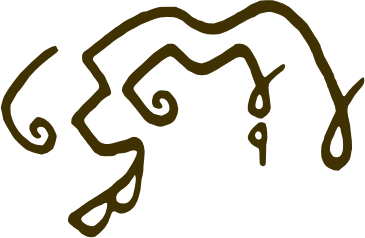
Mental repetition of BU DDHO, linked to the breath, is one of the oldest forms of ānāpānasati practised in SE Asia. BU is the third character of NA MO BU DDHA YA (see below), and corresponds to the element fire and the aggregate of perception. In the Khmer tradition it also corresponds to the “six silas in the citta” . This phrase refers to one of the four purifications of sila, that of "restraint of the senses" (Ñāṇatiloka, 1991, Buddhist Dictionary):
Whenever the monk perceives a form with the eye, a sound with the ear, an odour with the nose, a taste with the tongue, an impression with the body, an object with the mind, he neither adheres to the appearance as a whole, nor to its parts. And he strives to ward off that through which evil and unwholesome things, greed and sorrow, would arise if he remained with unguarded senses: and he watches over his senses, guards his senses. (Majjhima Nikaya, sutta 38), which is a description of the approach to jhāna.
As the in-breath (BU) becomes more subtle, the meditator may notice a still-rising “inner” in-breath, following the fading away of the coarse “outer” in-breath. This subtle breath develops into the nimitta of DDHO which resonates as O during the out-breath. In this way the “form” of the breath is discerned by the meditator. In terms of the more technical language of samatha meditation, the initial touch of the breath at the nose tip is the “preliminary work” nimitta, the parikamma nimitta. As the perception of the internal subtle breath develops, as a mind-based tactile and visual awareness, this is the “acquired sign” or uggaha nimitta. As the attention settles on this inner nimitta, which becomes more steady and peaceful as the meditator approaches jhānic absorption, it is termed the patibhāga nimitta or counterpart sign.
In Pāli, the vowel U at the start of a word adds the sense of “rising” or “higher”, and this is appropriate when intoning BU. Also, the form of the khom character for BU is additionally appropriate to represent the “breath body” because of its distinctive expansive form. A meditator familiar with this can internalise the form with the sound as he/she intones BU on the in-breath, to arouse energy and concentration. On the left below is a yantra made up of the two syllables BU and DDO, and to the right a yantra of nested BU syllables.
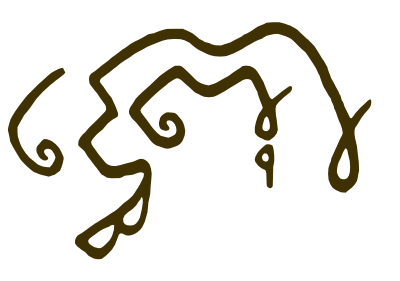
Yan Buddho

Yan Layers of Buddha
Many yan have multiple meanings depending on their use and the whim of the teacher, but they include a balance of name and form. As mentioned earlier, the term yan implies a quality of precision: the balance of concentration and tranquility - i.e. samatha - with discrimination. Without discrimination samatha can lead to a profusion of “tantras” (and “models” in general). But when the exuberance (pīti) of practice is tamed with discrimination, both samatha and vipassanā may be fulfilled together.
NA MO BU DDHA YA

These syllables occur frequently as a group of five in the Yogāvacara material such as the (probably 18th century) Yogāvacara’s Manual, and the palm-leaf manuscripts recovered by Bizot, such as the Five Branched Fig Tree and The Path of Lanka. They also appear in many yantra and sacred tattoos.
Apart from the literal meaning “Homage to the Buddha”, the syllables in theYogāvacara material typically represent (in order) the 5 elements earth, water, fire, air and space. Or, father, mother, king, family and teacher. Or, the 5 aggregates rūpa, vedanā, saññā, sankhāra and viññāna (form, feeling, perception, constructing, consciousness). Or, the embryo in the womb with 5 branches, arms, legs and head. Or, they can be taken to embody the entire essence of the books of the sutta, vinaya and abhidhamma pitakas.
Very occasionally, depending on the context, the meanings of NA and MO as father-mother or earth-water, are reversed to become mother-father, and water-earth; this might be an error in translating the oral tradition to a written form, but it is also possible that the context was making a different point - such as the interchangeability of nama-rūpa.
A

The character A (pronounced as in “hat”) has a very important role, one could almost say a cult of its own. Placed before Pāli words it “removes” the meaning, as in rūpa - form, and arūpa - absence of form. Or vijja - knowledge, and avijja - absence of knowledge. This is not the same as using new words “formless” or “ignorance”, which would become new concepts or “things”. In our language, too, A is sometimes used in the same way, but now pronounced as in “hay”, as in “apersonal”, this use coming from a Greek root.
“A” is also special in being the first letter of our alphabet, and as the indefinite article it can stand for anything. In Pāli, it can remove anything, and it is this sense of removing obstacles, or creating a break for something new to arise, that is at the heart of its role for the Yogāvacara . Sounded in the throat, the sound can be extremely short, almost to the point of preceding audible sound. It cuts, and in cutting creates a gap. The symmetrical or mirror form of the khom character for “A” is made use of to convey this - the two parts to represent the dual nature of mind, vijja-avijja as the root of suffering, while its unity is ekaggatacitta, one-pointedness of mind, a key factor in jhāna meditation. And if the symmetrical forms are superposed in a particular way, they cancel - like matter and antimatter - and emptiness results. Drawn as 5 parts, the character is said to represent the “breath of the Vinaya” (the 5 books of the Vinaya), or the placing of the mind at the 5 seats - the nose, back of palette, throat, heart and navel (as in the Path of Lanka).
MA A U

These three syllables (MA and A pronounced as in “hat”; and U as in “up”) also occur in many yantra, as well as in the Yogāvacara material. In another order, A U MA, they are related to the more familiar OM. In the MA A U usage, MA is the foundation (the body), A “cuts” to advert (the throat), and U is release upwards to attainment.
U at the beginning of Pāli words adds the sense of “higher”. Its use in yantra is frequently linked to the flame of deliverance upwards from the crown of the Buddha’s head - the usnisa (Skt.). In this case the form of the khom character for U is inverted to become the yantra equivalent of the usnisa, the unalom (Thai). MA A U also represent, in order, in-breath, out-breath and un-breath - the last a reference to the cessation of normal breathing in the 4th rupa jhāna, but also to foetal breathing in the womb; and again in the same order, dukkha, anicca and anatta. They are also used to convey the complete essence of the vinaya, sutta and abbhidhamma pitakas with different orders used in different contexts.
A RA HAṂ

The Pāli word Arahaṃ means “fully enlightened”, and the syllables appear frequently in the Yogāvacara texts as an evocation by the aspirant to attain that state.
In terms of the characters, A (as in hat) “cuts”, to leave space, RA (as in rang) “spins” the aspirant into the state, and HAṂ (as in hang) fixes the state. Unlike BU DDHO and ME TTA (below), which are two-dimensional and usually linked to the in-breath and the out-breath, A RA HAṂ is three-dimensional in its action.
ME TTA

These are the two syllables of the Pāli word for loving kindness, and like BU DDHO they are intoned silently on the in-breath and out-breath respectively. ME is sounded as somewhere between “metal” and “may”; and TTA as in “tar”. On the in-breath the invocation of loving kindness is directed to oneself, and on the out-breath to all other living beings. The Buddhist Metta Sutta likens the practice of metta to the love of a mother for her child,
In fact, Buddhist practice is full of maternal symbolism:, as for example, when a young man wishes to ordain as a monk, it is traditional that his mother offers to him his monk’s bowl, a symbol of the maternal womb; and he is also allowed to count 10 months in his mother’s womb towards the requisite age of 21 for ordination. At the end of the ordination ceremony, when the new monk transfers merit that he has obtained by ordaining, his mother is first on his mental list. And the Yogāvacara material makes frequent reference to the meditational journey as parallelling the development of the embryo in the womb, but towards enlightenment, the supramundane, rather than mundane existence subject to repeated suffering. It is also relevant that many words for mother in different languages use the root ma, such as Ma itself, or Mama; Mère; Mae (Thai) etc., and the first cries of a baby for mother are Mae, Mae .
SOME EXAMPLES OF THAI / CAMBODIAN YANTRA

This Ong Phra yantra is based on the body of the Buddha (“Ong” is body in monk’s language, and “Phra” is the honorific for a monk or Buddha image). The top portion contains the syllables BU THANG U DTA, followed in the mid-section by THA MANG A DTA SA NGAM PID TA - regarded as a powerful protection gatha popular in the armed forces as a “gunstopper”. The lower section contains the syllables NA MA BA DDA (standing for the 4 elements, earth, water, fire, air) and (I’m open to correction here) JA PA GA SA I GA WI DTI TA SANG MI. Around the outside are the syllables I SWAA SU MA A U.

Another Ong Phra yantra. In this example the top section contains MA. The mid section U A MA. The lower section NA MA U BA DA. And beneath NA MO BU DDA YA.
Yan Ong Phra are regarded as auspicious, and to provide insight and guidance.

The Yan Yod Mongkut is one of very few yan deemed suitable to be tattooed on the crown of the head. Very auspicious, as well as for protection.

The 5-spires yan is sometimes called the 5 peaks of Mt Meru. This and a 9-peak version are usually tattooed in the centre or upper back, and are regarded as highly auspicious. The number symbolism can be used in many ways, most often the 5 books of the Sutta Pitaka, and the 9 meditational attainments, the 4 rupa jhānas, the 4 arupa jhānas, and cessation the ninth. And other groups.

The Maha Ud yan, or “great blocker”, popular with armed forces and gangsters to make them invulnerable.

This 10-direction yan, Yan Sip Dtit is used for protection. There is also an eight direction version usually tattooed in the centre of the back.

This work is licensed under a Creative Commons Attribution.
The majority of images on this website are original to the site. We believe, following exhaustive checks, that all others are open-source, but if any visitor thinks otherwise do please contact us at info@itipiso.org

